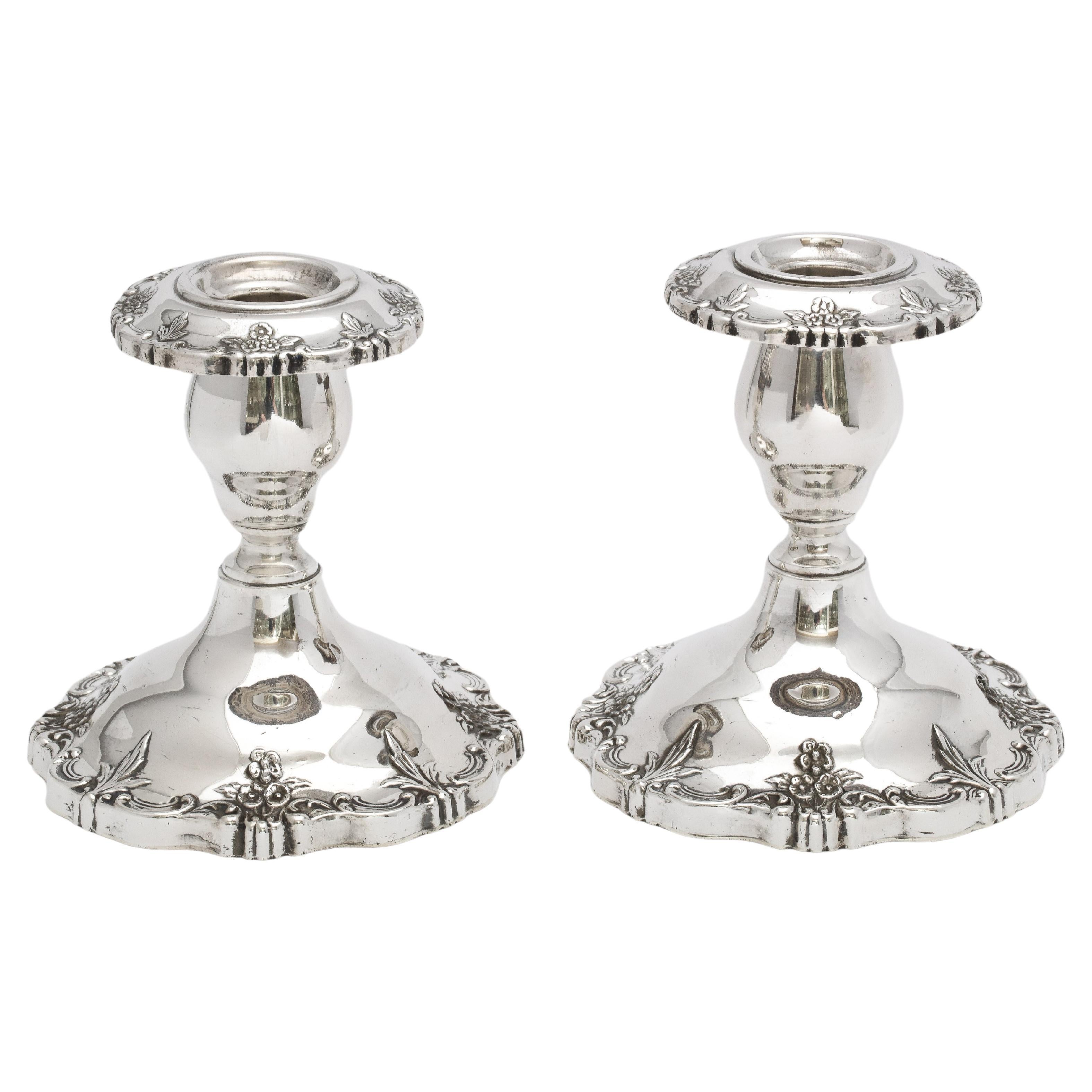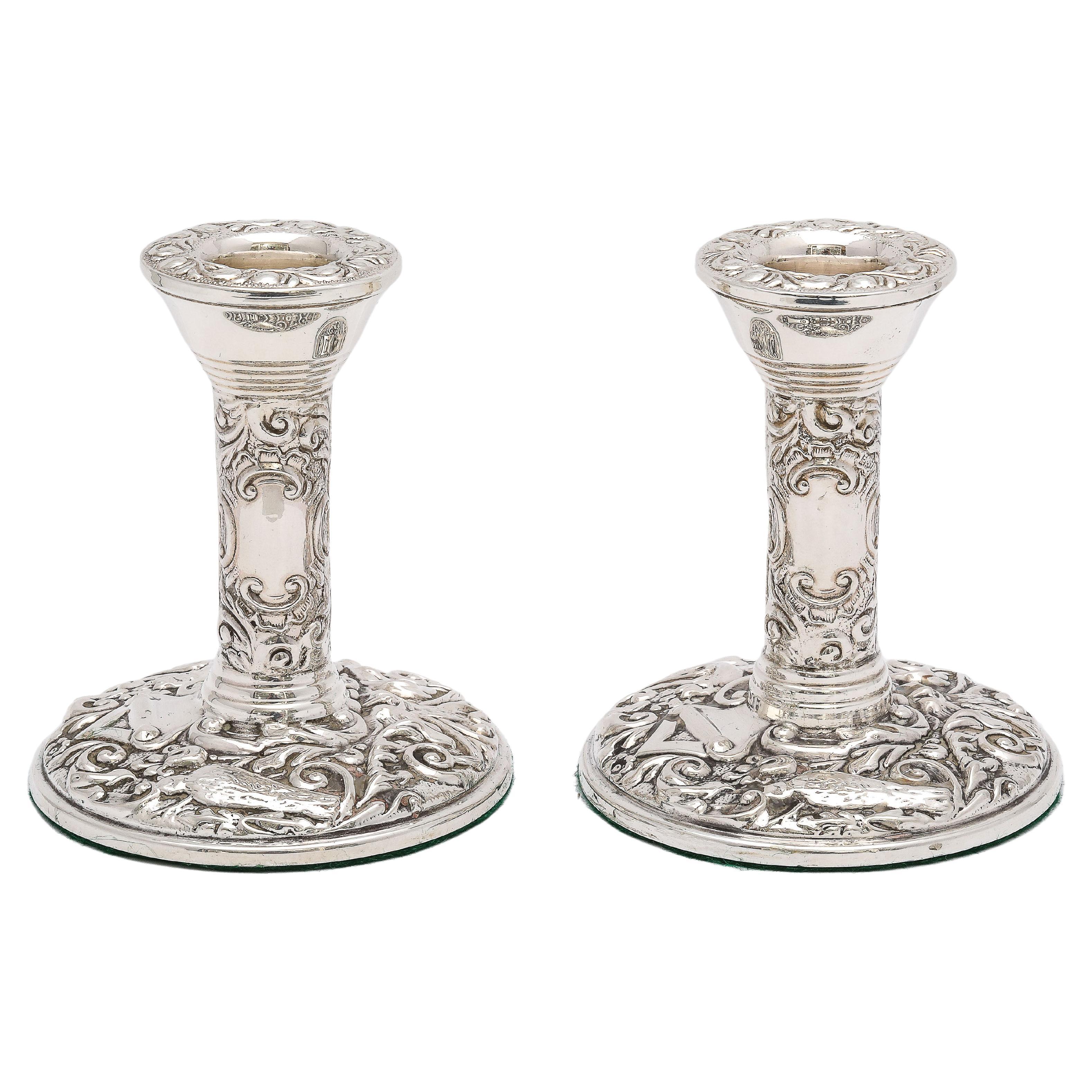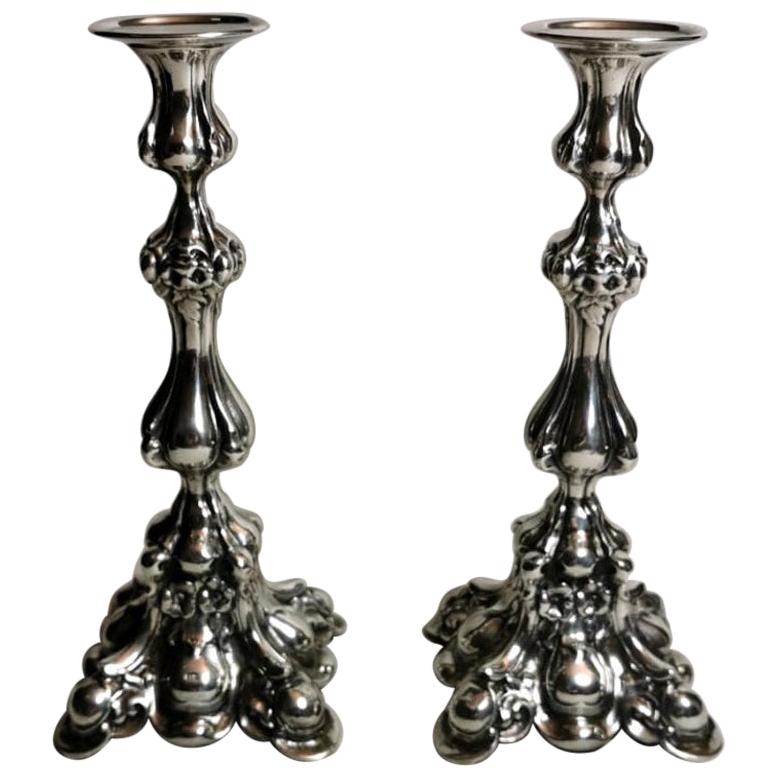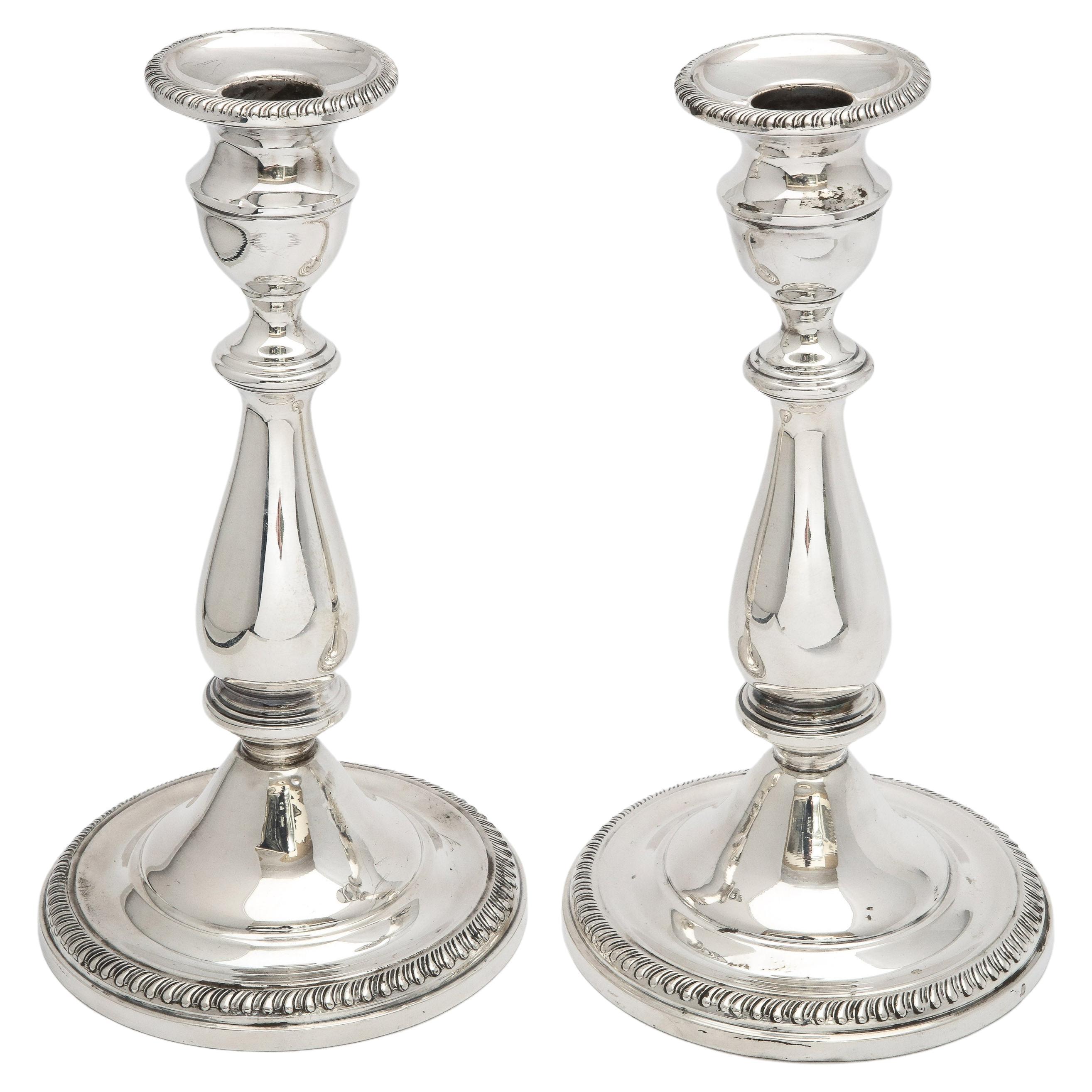Items Similar to Pair of David Heinz Gumbel silver candlesticks, modern Judaica, Bauhaus style
Want more images or videos?
Request additional images or videos from the seller
1 of 7
Pair of David Heinz Gumbel silver candlesticks, modern Judaica, Bauhaus style
About the Item
We are offering here this perfectly designed pair of sterling silver candlesticks, all hand Hammered in a fine and sleek Bauhaus design, the candlesticks were made after Gumbel Left his work in the bezalel school of arts in Jerusalem, they date from the 60s'.
This pair will be an amazing addition to any Judaica or silver collection, and will be Amazing in any house with their Bauhaus, delicate hammered sleek design.
The candlesticks are both marked 925 for sterling silver and the latter "G" in Hebrew for "Gumbel"
Measurements:
Height : 9.7 inch / 24.8 cm
Width : 3.6 inch / 9.1 cm
Master silversmith David Heinz Gumbel, was born in Sinsheim, Germany, near Heidelberg. He studied at the Kunstgewerbeschule in Berlin-Charlottenberg from 1927 to 1931. Although Gumbel did not actually study at the Bauhaus, he was profoundly Influenced by its teachings and incorporated its design aesthetic into his silver and Judaica. In 1934 Gumbel fled Nazi Germany and moved to Palestine. As a member of the Faculty of the recently opened New Bezalel School in Jerusalem, he joined a group of Highly cultured artists and colleagues who worked under the directorship of Joseph Budko, a craftsman who championed the modernist aesthetic. Gumbel taught Silversmithing, hammered work, and jewelry design at Bezalel, and retired in 1955. His Personal style always remained classic modern -- his objects emphasize streamlined Design and graceful contours.
He was born in Sinsheim to a secular family among the pioneers of the local silversmith Industry. In 1918, the Gumbels relocated to Heilbronn where David worked as an Apprentice in the "Bruckmann & Sons" factory, becoming a certified steel engraver.
In the late 1920s, Gumbel studied to be a silversmith at the school of applied arts in Berlin At the Kunstgewerbeschule. Following his studies, Gumbel was employed at workshops In Düsseldorf and Stockholm, as well as in the family factory in Heilbronn. It was there that Gumbel began to design hand-made silver pieces in the modern style. Simultaneously, He produced Jewish ritual objects like a Chanukah menorah or candlesticks. Gumbel Utilized polished silver and other materials, such as ivory, in his works.
In 1936, Gumbel left Germany for Land of Israel, joining the Bezalel Academy of Arts and Design as a teacher and the administrator of the metal department, alongside Ludwig Yehuda Wolpert. Once in the Land of Israel, Gumbel began to work with typography, Ostensibly as a result of Wolpert's influence.
Despite Gumbel's modern approach to design, he continued to work with and teach the Traditional methods of manual manufacturing, such as repoussé. In the early 1940s, he Opened an independent workshop where he produced metal works and Judaica pieces In said silversmith techniques.
Gumbel retired from his work at Bezalel in 1955. In his will Gumbel left the continuation of His creation to the artist Malka Cohavi, his assistant and teacher at Bezalel Academy of Art and Design.
- Dimensions:Height: 9.7 in (24.64 cm)Diameter: 3.6 in (9.15 cm)
- Sold As:Set of 2
- Style:Bauhaus (In the Style Of)
- Materials and Techniques:Silver,Hammered
- Place of Origin:
- Period:
- Date of Manufacture:1960s
- Condition:Wear consistent with age and use. GoodWear consistent with age and use. Perfect condition to its age, no brakes, no restorations, Some minor scratches and age related wear.
- Seller Location:Tel Aviv - Jaffa, IL
- Reference Number:1stDibs: LU8130235523792
About the Seller
No Reviews Yet
Vetted Seller
These experienced sellers undergo a comprehensive evaluation by our team of in-house experts.
1stDibs seller since 2023
- ShippingRetrieving quote...Ships From: Tel Aviv - Jaffa, Israel
- Return PolicyThis item cannot be returned.
More From This SellerView All
- Silver Hanukkah Lamp made by Eli Gera, modern Judaica, Israel, Tel Aviv 1970s.Located in Tel Aviv - Jaffa, ILVery rare and important piece of Israeli modern Judaica, a bauhaus style silver Hanukkah Lamp made by the famous jewish silversmith Eli Gera, made from hand bent And hand Forged silver in the 70s, while other works by Gera were multiplied by him, from What we Know this piece is a one of a kind. Marked "SILVER 925" and ELI GERA in Hebrew and English on a small silver plaque on the base. Measurements: Height: 3 inch / 7.6 cm Width: 11.8 inch / 30 cm Depth : 3.3 inch / 8.5 cm Condition : Perfect condition for its age, no brakes, no restorations, some minor scratches and age Related wear About the artist : Please note the Victoria & Albert Museum in London holds an Hanukkah lamp Havdalah Set...Category
Vintage 1970s Israeli Bauhaus Sterling Silver
MaterialsSilver
- Russian silver torah shield, judaica, Michael Karpinsky, Saint Petersburg, 1835Located in Tel Aviv - Jaffa, ILRare and exceptional example of early russian Judaica, this torah shield or tas is made From 84 silver, has the marks of the city of saint Petersburg, together with the makers Mark o...Category
Antique 1830s Russian Neoclassical Revival Sterling Silver
MaterialsSilver
- An Israeli sterling Silver Tzedakah box, Judaica, by Carmel Shabi, 1994Located in Tel Aviv - Jaffa, ILTzedakah box of flattened oviform shape (round fish shape) , amazing sleek and Modernistic design. just a masterpiece of design. Pierced with stylized H...Category
1990s Sterling Silver
MaterialsSilver
- extremely rare Algerian Judaica silver, jewish Dowry box early 19th centuryLocated in Tel Aviv - Jaffa, ILAmazing and scarce JUDAICA object, we have here one of the most touching jewish objects we had for a long time, this small silver dowry box was made in Algeria in the early 19th century, it is all covered with symbols of jewish faith and of couples, the sliding lid has 2 flanking birds with hamsa (protective hand) on each side and a flower vase in the middle. one side shows two flanking lions with a tree in the middle and the other side shows again two big and two small birds with a flower bowl in the middle, front side has a key hole and next to it there is the Hebrew inscription ס״ט״" which says Siman tov or in English "a good sign" it is taken from the wedding blessing, underneath the lock there is another inscription with the name ״עזיזה בת אברהם בן חמו״ which is the name of the bride, her father and her grandfathers name. the box is full marked a lot of times with the silversmith mark, every side of the box is marked. this box was probably ordered by the grooms family to hold the jewelry they are giving to the bride as dowry, this type of objects are rare and there are just a few of them on museum collections. DOWRY (Heb. נְדֻנְיָה), the property a wife brings to her husband at marriage; the Yiddish equivalent, nadn, is from the same root. The custom of nedunyah became clearly defined and institutionalized only in the talmudic period. In biblical times, mohar (מֹהַר), whereby the groom bought his wife from her father (Gen. 24:53; Ex. 22:15–16; Hos. 3:2), was the accepted practice. It was then customary that the groom give the bride gifts, and that she bring certain property to her husband's home upon marriage: slaves, cattle, real estate, etc. (cf. Gen. 24:59–61; 29; Judg. 1:14ff.; I Kings 9:16). Evidence of the custom of nedunyah is to be found in Tobit (7:14; 8:21) and in the Assuan papyri (Cowley, Aramaic, nos. 15, 18). Gradually, mohar was superseded by the ketubbah custom according to which the husband merely assumed the responsibility of compensation to his wife in case he divorced her: he had to pay her 200 zuzim if she had been a virgin at the time of marriage, and 100 zuzim if a widow or divorcée (see *Ketubbah). By talmudic times, the institution of nedunyah was prevalent; the father gave a dowry to the bride since the daughter was excluded from paternal inheritance. Fifty zuzim (equivalent to the worth of 180 grams of silver) was the minimum amount a father was obliged to give to his daughter (Ket. 6:5). Parents usually gave much more, according to their social standing. Community funds provided the dowry for an orphan or a very poor girl (ibid.; cf. Sh. Ar., YD 251:8). In case of her father's death, the brothers of a minor girl were obliged to give her the minimum dowry, and the court estimated how much her father would have given her above the minimum dowry. The sum was then taken out of the father's estate and given to the daughter upon majority (Ket. 6:6; 68a–69b). In the absence of such an estimate, each daughter was entitled to receive one-tenth of the value of her father's estate in money, or in valuables (Yad, Ishut, 20:4–7; Sh. Ar., EH 113:4). If the father was unable or unwilling to pay the promised dowry at the betrothal ceremony, the groom could refuse to marry his bride (Ket. 13:5; Ket. 108b–109a). Insistence on exact payment of the promised dowry, however, was frowned upon by later rabbinic authorities (Rema to Sh. Ar., EH 2:1). In certain communities it was customary for the groom's father to make a dowry contribution equal to that of the bride's father (Ket. 102b). The dowry, whether given in real estate, slaves, money, or chattel was recorded in the marriage contract (the ketubbah) and in some instances one-third or one-fifth of the actual value of the dowry was added to the sum mentioned in the ketubbah. Based upon a decree enacted by *Simeon b. Shetah (first century C.E.), the Talmud ruled that the husband and his entire property were liable for compensation as stipulated in the ketubbah, either in case he died (when she collected the sum specified in the ketubbah from the heirs) or in case he divorced his wife (Ket. 82b). For the status of the dowry and the husband's rights and obligations, see below. The rabbinic enactments (Takkanot Shum) by R. Jacob *Tam and by the rabbinic synod of the communities of Speyer, Worms, and Mainz (Germany) stipulated that if a woman died...Category
Antique Mid-19th Century Algerian Tribal Art
MaterialsSilver
- Rare early Bezalel Jerusalem JUDAICA etched brass garden of eden plateLocated in Tel Aviv - Jaffa, ILvery rare Bezalel Jerusalem plate , this amazing plate has the best subject And artistic Design i have seen in a lot of years, the plate has 5 different scenes from the story Of Adam...Category
Vintage 1910s Israeli Arts and Crafts Decorative Dishes and Vide-Poche
MaterialsBrass
- French faience Passover plate, JUDAICA 19th centuryLocated in Tel Aviv - Jaffa, ILthis plate has a creme white background, the center painted with a man holding a lamb before a cityscape, probably a depiction of Jerusalem by someone who never actually visited the city or even see it, under the man there is the word Passover "פסח" the rim with the order of the Seder, and some grape vines between them. Passover, also called Pesach ( Biblical Hebrew: חַג הַפֶּסַח, romanized: Ḥag haPesaḥ), is a major Jewish holiday, one of the three pilgrimage festivals, that celebrates the Biblical story of the Israelites' escape from slavery in Egypt. Pesach starts on the 15th day of the Hebrew month of Nisan which is considered the first month of the Hebrew year. The Hebrew calendar...Category
Antique Late 19th Century French Victorian Platters and Serveware
MaterialsPottery
You May Also Like
- Bauhaus Style CandlesticksBy BauhausLocated in New York, NYPair of brass candlesticks in the style of the Bauhaus. Stamped "Made in Germany." This pair of industrial candlesticks follow the Bauhaus school of design's philosophy of "form fo...Category
20th Century German Bauhaus Candlesticks
MaterialsBrass
- Pair of Sterling Silver Candlesticks by David LawrenceLocated in London, GBA pair of Elizabeth 2nd Sterling silver modernist twin head candlesticks Birmingham 1965 by David Lawrence silverware - Hallmarked Dimensions: D:7.8c...Category
Vintage 1960s Candlesticks
MaterialsSterling Silver
- Pair of Victorian-Style Sterling Silver CandlesticksBy W I Broadway & Co.Located in New York, NYPair of Victorian-Style, sterling silver candlesticks, Birmingham, England, year-hallmarked for 1972, Broadway and Co. - makers. Each candlestick measures 4 inches high x 3 1/4 inche...Category
Vintage 1970s English Victorian Candlesticks
MaterialsSterling Silver
- Pair of Victorian Style Sterling Silver CandlesticksLocated in New York, NYPair of Victorian-Style, sterling silver candlesticks, Fisher Silversmiths, Inc., Jersey City, New Jersey, Ca. 1935. Each candlestick measures 5 inches high x a little under 4 3/4 in...Category
Vintage 1930s American Victorian Candlesticks
MaterialsSterling Silver
- Italian Rococo Style Pair of Silver CandlesticksLocated in Prato, TuscanyWe kindly suggest you read the whole description, because with it we try to give you detailed technical and historical information to guarantee the authenticity of our objects. Parti...Category
Mid-20th Century Italian Rococo Candlesticks
MaterialsSilver
- Edwardian-Style Pair of Sterling Silver CandlesticksBy Mueck-Carey Co. 1Located in New York, NYEdwardian style, sterling silver candlesticks, The Mueck-Carey Co., New York, Ca. 1940's. Each candlestick measures 9 inches high x 4 3/4 inches diameter and each is designed with a...Category
Vintage 1940s American Edwardian Candlesticks
MaterialsSterling Silver
Recently Viewed
View AllMore Ways To Browse
David Heinz Gumbel
Ludwig Yehuda Wolpert
Vintage Menorah Israel
Silver Designs From Jerusalem
Judaica Candlestick
Metal New Candlesticks
Jewish Candle Holder
Ivory Candle Holder
1960s Menorah
Israeli Objects
Menorah Hebrew
Sterling Judaica Candlesticks
Vintage Jewish Jewelry
Vintage Silversmith Hammer
Sterling Candlesticks Repousse
Silver Candlesticks Jewish
Gilt Candle Sticks
Amber Rose Hurricanes





